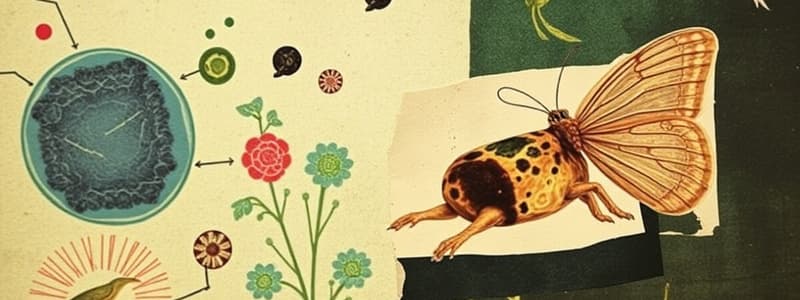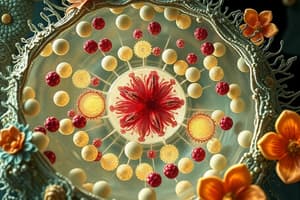Podcast
Questions and Answers
Which structure is unique to plant cells and not found in animal cells?
Which structure is unique to plant cells and not found in animal cells?
- Ribosomes
- Chloroplasts (correct)
- Mitochondria
- Nucleus
What is the primary function of ribosomes in both plant and animal cells?
What is the primary function of ribosomes in both plant and animal cells?
- Photosynthesis
- Energy production
- Protein synthesis (correct)
- Storage of genetic material
What is the main component of the cell wall in plant cells?
What is the main component of the cell wall in plant cells?
- Peptidoglycan
- Cellulose (correct)
- Protein
- Chitin
Which of the following best describes the vacuole in plant cells?
Which of the following best describes the vacuole in plant cells?
How do bacterial cells differ from plant and animal cells in terms of genetic material?
How do bacterial cells differ from plant and animal cells in terms of genetic material?
What role does the mitochondria play in both plant and animal cells?
What role does the mitochondria play in both plant and animal cells?
Which structure regulates what enters and exits the cell?
Which structure regulates what enters and exits the cell?
Which statement is true regarding the shape of plant cells compared to animal cells?
Which statement is true regarding the shape of plant cells compared to animal cells?
What is the primary function of the nutrients present in the cytoplasm of egg cells?
What is the primary function of the nutrients present in the cytoplasm of egg cells?
What happens to the cell membrane after fertilization of the egg cell?
What happens to the cell membrane after fertilization of the egg cell?
If the image size of a specimen is 72 mm and the magnification is x 300, what is the actual size in mm?
If the image size of a specimen is 72 mm and the magnification is x 300, what is the actual size in mm?
How many micrometres are in 3 mm?
How many micrometres are in 3 mm?
What is the role of haploidy in egg cells?
What is the role of haploidy in egg cells?
Which of the following correctly defines a tissue?
Which of the following correctly defines a tissue?
If an image of a cell is measured at 45 mm under x 100 magnification, what is the actual size in µm?
If an image of a cell is measured at 45 mm under x 100 magnification, what is the actual size in µm?
Which level of organization is composed of different types of tissues working together?
Which level of organization is composed of different types of tissues working together?
What is the primary function of ciliated cells in the trachea?
What is the primary function of ciliated cells in the trachea?
Which of the following cells contains plasmids?
Which of the following cells contains plasmids?
How are palisade mesophyll cells adapted for photosynthesis?
How are palisade mesophyll cells adapted for photosynthesis?
What adaptation allows red blood cells to efficiently carry oxygen?
What adaptation allows red blood cells to efficiently carry oxygen?
What unique feature do sperm cells possess to enhance their mobility?
What unique feature do sperm cells possess to enhance their mobility?
What role do dendrites play in nerve cells?
What role do dendrites play in nerve cells?
Which statement about egg cells is correct?
Which statement about egg cells is correct?
What feature is essential for root hair cells to maximize nutrient uptake?
What feature is essential for root hair cells to maximize nutrient uptake?
Flashcards
What is a cell?
What is a cell?
The basic building block of all living organisms.
What is a tissue?
What is a tissue?
A group of similar cells working together to carry out a particular process.
What is an organ?
What is an organ?
A group of tissues working together to carry out a specific function.
What is an organ system?
What is an organ system?
Signup and view all the flashcards
What happens to the egg cell membrane after fertilization?
What happens to the egg cell membrane after fertilization?
Signup and view all the flashcards
What is fertilization?
What is fertilization?
Signup and view all the flashcards
What is image size?
What is image size?
Signup and view all the flashcards
What is actual size?
What is actual size?
Signup and view all the flashcards
Cytoplasm
Cytoplasm
Signup and view all the flashcards
Cell membrane
Cell membrane
Signup and view all the flashcards
Nucleus
Nucleus
Signup and view all the flashcards
Ribosomes
Ribosomes
Signup and view all the flashcards
Mitochondria
Mitochondria
Signup and view all the flashcards
Vacuole
Vacuole
Signup and view all the flashcards
Chloroplasts
Chloroplasts
Signup and view all the flashcards
Cell wall
Cell wall
Signup and view all the flashcards
What are plasmids?
What are plasmids?
Signup and view all the flashcards
What are cilia and where are they found?
What are cilia and where are they found?
Signup and view all the flashcards
What are specialised cells?
What are specialised cells?
Signup and view all the flashcards
How are root hair cells specialized?
How are root hair cells specialized?
Signup and view all the flashcards
How are palisade mesophyll cells specialized for photosynthesis?
How are palisade mesophyll cells specialized for photosynthesis?
Signup and view all the flashcards
How are neurons specialized for transmitting information?
How are neurons specialized for transmitting information?
Signup and view all the flashcards
How are red blood cells specialized for carrying oxygen?
How are red blood cells specialized for carrying oxygen?
Signup and view all the flashcards
How are sperm cells specialized for fertilization?
How are sperm cells specialized for fertilization?
Signup and view all the flashcards
Study Notes
Cell Structure
- Animal cells and plant cells share some structures like nuclei, cytoplasm, mitochondria, ribosomes, and cell membranes.
- Plant cells differ by having cell walls, vacuoles, and chloroplasts.
- Plant cells are typically larger and have more regular shapes than animal cells.
Cell Structure Functions
- Cytoplasm: The jelly-like substance within the cell where reactions occur; contains ribosomes and vesicles.
- Cell membrane: A thin membrane that controls the entry and exit of substances.
- Nucleus: Contains DNA, which codes for proteins; where DNA replication occurs.
- Ribosomes: Sites of protein synthesis.
- Mitochondria: Sites of respiration, providing energy for the cell.
- Vacuole (plants only): A fluid-filled sac containing mineral salts, sugars, amino acids, waste, and pigments to attract pollinators.
- Chloroplasts (plants only): Sites of photosynthesis, converting light energy into glucose.
- Cell wall (plants only): Provides structure and prevents bursting; made of cellulose.
Bacterial Cells
- Bacterial cells have a cell wall, cell membrane, cytoplasm, and ribosomes.
- Bacterial cell walls are made of peptidoglycan, different from plant cell walls.
- Bacterial cells lack a nucleus, with a circular DNA loop instead.
- They also lack mitochondria and chloroplasts.
- Bacterial cells contain plasmids, which are small rings of DNA.
Specialized Cells
-
Ciliated cells: Line the trachea, have hair-like projections (cilia) to move mucus, dust and bacteria upwards.
-
Root hair cells: Adapted for a large surface area, speeding up osmosis and mineral ion uptake in plants.
-
Palisade mesophyll cells: Tall and closely packed, absorbing light efficiently for photosynthesis.
-
Neurons: Rapidly transmit electrical impulses; myelinated for insulation; many mitochondria for energy; branched dendrites.
-
Red blood cells: Contain haemoglobin to carry oxygen; have a biconcave shape to increase surface area for faster diffusion; lack a nucleus.
Gametes
- Sperm cells: Contain numerous mitochondria for energy, a tail for movement, and digestive enzymes to penetrate the egg cell membrane. They have half the chromosomes of normal cells.
- Egg cells: Contain nutrients for embryo growth; prevent further sperm entry after fertilization; contain half the chromosomes of normal cells.
Levels of Organization
- Cell: Basic building block of life.
- Tissue: A group of similar cells working together.
- Organ: A group of tissues working together.
- Organ system: A group of organs working together.
Size of Specimens
- Use the formula: Actual size = Image size / Magnification
- Measure image size in millimeters.
- Convert to micrometers by multiplying by 1000 (1 mm = 1000 μm).
Studying That Suits You
Use AI to generate personalized quizzes and flashcards to suit your learning preferences.




